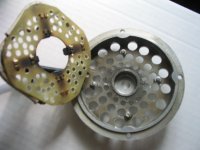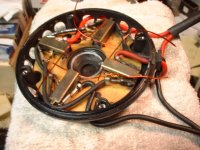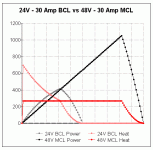TylerDurden
100 GW
These motors are used mostly at 24V, but 36V is manageable and 48V possible if the motor is cooled.
Even if the motor is run at 24V, cooling can help it run more efficiently: it will pull harder, go faster, and live longer simply because the copper windings have less resistance when they are cooler. This is not rocket science. We're just helping the hot air escape the normally closed motor.
It is easy to take the motor apart, just remember where the stuff goes or take notes and pictures as you work. Keep rags handy and have some bearing grease available for the gearbox. Ziplock baggies are helpful to keep parts organized.
I used a 1/2" electric-drill, a rotary-tool (dremel type), a nibble-tool and a 4" abrasive disc.
Here's the gearbox-side cover. The metal is soft and easy to work. Wearing gloves and eye protection is advised. Holes were drilled and the nibble tool was used to chew out the rough shape. The edges were smoothed with the rotary tool.
Here's the brush-side cover. The rotary tool is used to narrow the posts where they were staked to hold the brush-plate.
A tool can be made by flattening a nail and bending it:
The plate can be lifted by slipping the tool under the plate by each post and turning the tool like a crank.
Now comes the fun part!
The drill was clamped pointing up, for the abrasive wheel to sit level. Grooves were made deeper in the ring by moving the ring back and forth while supported on a block. They were not cut so deep as to hit the embedded steel ring, just enough to maximize the surface area. (Ambitious 48V currie-coolers may want to insert 1/2" tall aluminum fins.)
Imagine you are the rotor... better, eh?
A hole was drilled slightly larger than the brush-end of the motor shaft. This should permit attachment of an extension of the shaft, so a mechanical fan can be attached. The extension could be brazed, using the shallow hole as a site for a stem to be inserted and brazed around. Crennelations (radial notches) could be added with a rotary tool and cutoff disc for better bite. (The shaft is hardened, so it might break a tap, if you try to put threads into the shaft.) Alternatively, a slow-setting epoxy like JBweld could be molded onto the end by filling a short tube that just slips over the end (cut the tube off after the epoxy sets). Once a stem extends out from the case, a fan could be added by tapping the extension, or making a keyway or flat.
Time for a cuppa.
A coffee tin can be easily marked by using the case as a guide. Marking vertical lines will help locate tabs where mounting holes can be made.
This is a bit tall for a prop-type fan, but might be good for a squirrel-cage fan. The diameter fits the case very well. Being made of metal, it is durable and easily modified. Openings could be made in the sides or end; protection from the elements could be in the form of louvers or screens. An electric fan could be added inside. The tradoffs for electric are minor: electric requires an interface to the power-supply, but it could spin fast even at low RPMs; obviously, the mechanical fan follows motor speed. As ES member The7 points out: there is an advantage to moving the air out at the brush end, to reduce residue buildup on the windings.
The commutator was cleaned of brush residue by simply securing the rotor-stem in the chuck of a drill and spinning it while gently applying 400 grit sandpaper. Copper dust should be wiped off, especially out of the gaps, to avoid arcing. When inserting the rotor into the stator-ring, be advised: those magnets are strong. To make it easy, the stator should be held to the table by a clamp and the rotor should be held firmly in both hands, out by the slots. The rotor should be in alignment with the gearbox-end bearing as it is lowered into the ring. The magnets will suck the rotor right outta your hands if you do not hold it tightly and support your hands/arms as you lower the rotor. At the point where you are certain the end of the shaft has entered the bearing, you can relax your grip and let the rotor snap into place. Your fingers will probably get pinched, so snug gloves are a good idea.
The brush-end bearing has a spring-washer to keep the rotor pushing toward the gearbox. Ensure that the bearing can move in and out by pushing it against the spring and letting it return. Any binding should be eliminated, by lubricating with graphite or teflon spray. Fechter's tip on using thin wire to hold the brushes is great, especially if you have holes in the case to withdraw the wires through: it permits screwing-down the cover first (which should have some "spring" to it, before it seats on the ring, due to the spring-washer behind the rotor bearing).
Prior to closing this motor, a temperature probe was fastened such that the tip extends into the case just above the windings of the rotor. The probe can be connected to a DMM described in another post: http://endless-sphere.com/forums/viewtopic.php?t=1867 . For testing the difference in temp, the new openings in the motor will be covered with aluminum-foil and readings taken at various loads. The the foil will be removed and the same process will be replicated on another day.
The motor was installed into the bike using washers as standoffs, to permit airflow into the gearbox side. The required widening the mounting slots in the frame to keep the chainline straight, since the motor would be 1/4" further to the right. Air can flow around the gaps and into the openings. The motor barely clears the chain on the rightside, where the brushes are.
Some of the members may recall the bike once looke like this:

My new urban location required conversion fom Moto-X to urban-assault/ghetto-blaster (tough hood). The paint-job was not intended to look camo... it just came out that way. More rusty-metal primer or dark brown will be added to tone down the desert-camo quality. The crate on the front is very handy to toss the lipos into and the bike balances well. The suspension is a bit soft in front but not sloppy. The stock battery case is empty except the controller. A lipo/avionics case is forthcoming, such that displays and batteries all are carried in at any destination.
The 4" pvc pipe raises the rider up enough to pedal properly and creates a fine place to carry long, narrow items like: golf-umbrella, pipe, mouldings, etc.
Prelim test: 25C ambient
Outbound, WOT, uncovered motor, 3mi. - Temps peaked at 52C, after climbing a long, low grades.
Return, WOT, covered motor, 3mi. - Temps peaked at 56C, after climbing a long, low grades.
Peaks occured when motor was stopped. Running the motor, even under load resulted in temp drop.
Average crusing temperature about 48C
That's all so far.





